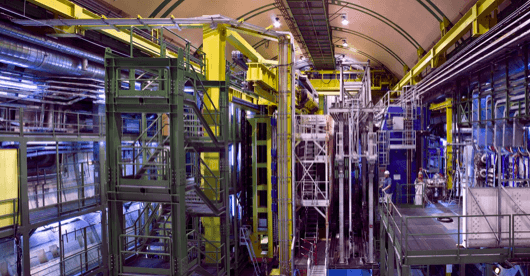
The LHCb detector that recently discovered pentaquarks. Source: 2008 CERN, photo Maximilien Brice, flickr.
On July 14, 2015, the LHCb (Large Hadron Collider beauty) experiment at CERN’s Large Hadron Collider announced the discovery of a new form of matter: the pentaquark particle. The theory describing these particles has existed since 1964, when the physicist Murray Gell-Mann proposed that protons and neutrons are made of more fundamental particles called quarks. However, it took the revamped LHC to produce collisions energetic enough to finally observe these particles in nature (1).
There are six known types, or “flavors,” of quark: up, down, top, bottom, charm, and strange (2). Particles called baryons, including protons and neutrons, consist of three quarks. Other particles, known as mesons, contain two (1). The theory does not prevent groups of four, five, or more quarks from forming (2). But until recently, none of these larger groups of quarks had been conclusively observed in nature.
The LHCb group was not actively searching for pentaquarks. Instead, the experiment was looking at the decay of baryons, another three-quark particle (2). In this decay, though, scientists discovered that intermediate pentaquark particles form (2). These intermediate states appeared accidentally to the scientists as inexplicable “bumps” in the data (3).
The pentaquark contains two up quarks, one down quark, one charm quark, and one anti-charm quark, the charm quark’s antimatter equivalent (1). To fully describe the data, two states of this particle are necessary: one with a mass of 4380 MeV and the other with a mass of 4449.8 MeV. The significance of each of these states is more than nine standard deviations, meaning that the probability of a false positive result is less than one in 1019 (4). In other words, these results are about as positive as they come.
There remains much to learn about these pentaquarks. Scientists still do not know exactly how the pentaquarks are structured—the five quarks could all be tightly bound, or they could form two separate groups that are weakly attracted together (1). Whatever this research uncovers, it will probe unexplored regions of physics and broaden our understanding of the fundamentals of matter.
References:
- (2015, July 14). CERN’s LHCb experiment reports observation of exotic pentaquark particles. ScienceDaily. Retrieved July 21, 2015 from www.sciencedaily.com/releases/2015/07/150714082858.htm
- Thompson, Helen. (2015, July 17). What Is a Pentaquark and Why Are Physicists so Excited About It? Smithsonian. Retrieved July 21, 2015 from http://www.smithsonianmag.com/smart-news/what-heck-pentaquark-180955942/?no-ist
- Chalmers, Matthew. (2015, July 14). Forsaken pentaquark particle spotted at CERN. Nature. Retrieved July 21, 2015 from http://www.nature.com/news/forsaken-pentaquark-particle-spotted-at-cern-1.17968
- LHCb collaboration. (2015, July 13). Observation of J/ψp resonances consistent with pentaquark states in Λ0b→J/ψK−p decays. Physical Review Letters. Retrieved July 21, 2015 from http://arxiv.org/abs/1507.03414